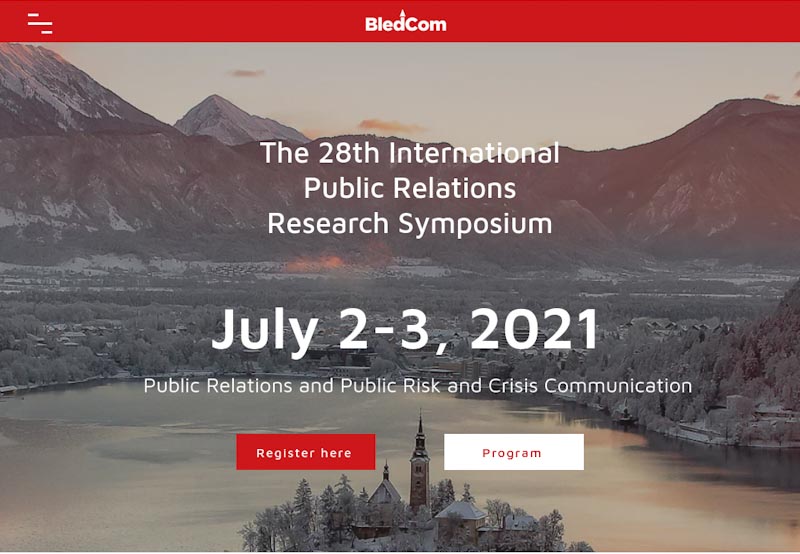Dealing with a communicative virus
Some thoughts on a virtual BledCom 2021
About the author
Thomas Stoeckle leads the AMEC International Certificate in Measurement and Evaluation for PR Academy and is a part-time lecturer at Bournemouth University.

“BledCom 2021: it was good, but it was not the same” seems like a good way to round up the 28th edition of this very unique annual gathering of PR practitioners, academics and students in the most outrageously scenic and idyllic setting of Lake Bled in Slovenia (unless, as last year, and again this year, it all has to be done virtually due to pandemic safety concerns and international travel restrictions).
So, a BledCom unlike any other prior to 2020, and thanks to event organizers Confiva, a pretty slick affair of Pecha Kucha style 5 min presentations (though truth be told Pecha Kucha gives you 400 seconds instead of 300…) and a number of excellent panel sessions. More of that shortly. The global BledCom family showed up in numbers: 151 attendees from 39 countries, 103 speakers across nearly 70 presentations and six panels over two days, all expertly and warmly conducted by joint organisers and masters of ceremony, Ana Tkalac Vercic, Dejan Vercic and Krishnamurthy Sriramesh.
Through the regular breaks – more than necessary to let the brain recover and regenerate briefly from the relentless onslaught of rich information and insight from academic studies, models and perspectives – attendees were reminded of those halcyon days of pre-pandemic gatherings in various locations around the lake and in nearby eateries through delightful photo montages. And I must say, Jon White’s 90s moustache was a definite highlight for me.
“Public Relations, Public Risk and Crisis Communication” was this year’s motto, and EUPRERA president Angeles Moreno set the scene by stating that “professional communication can save lives” and “public relations practitioners are key to managing a pandemic as they can facilitate and maintain relations and mutual understanding between institutions and the public.” But then none of this happens in a vacuum and as Darren Lilleker and I state in a forthcoming paper, in the case of the UK, often public health communication needs and political campaigning impulses by the government were at odds, with suboptimal outcomes from a public health perspective.
Situational Crisis Communication Theory (SCCT) and dialogic Excellence Theory (ET) appeared to reign supreme among chosen approaches, and Dejan Vercic suggested that more involvement of communication scientists would beat the “communicative virus” – the practice reality check revealed regular misalignments between political and economic self-interest on the one hand, and public health (communication) needs on the other. Denisa Hejlova of Charles University in Prague made this clear when she explained “why hiring a political marketing expert didn’t work in government COVID communication.” If only SCCT and ET were applied purely, as intended in the models.
Thus, an interesting chasm became apparent, between a “PR to the rescue” brigade and their “PR is part of the problem” counterparts.
In the case of ‘COVID comms’, it feels like there is more evidence for the case that PR either doesn’t actually matter, or has been recruited to sell self-serving political campaigning rather than consistent public health messages. Which, somehow, makes me think of my beloved Tristram Shandy: “When things move upon bad hinges, an’ please your lordships, how can it be otherwise?”
There is a sense, though, that it can be otherwise, and perhaps ought to. The likely correct answer, to misquote Irma Meyer and her very insightful take on metamodernism and stakeholder relationship management, is “both, and”, as well as “both, neither.” We know from Thomas Kuhn – he of the paradigm shift – that crises trigger change. And from Albert Einstein – apocryphal or not – that the thinking that gets us into a mess is rarely the right thinking to get us out of it too.
Which brings me to the perhaps most important section of this year’s BledCom conference – and I have to declare an interest here due to personal involvement: the panel led by Ana Adi on “The Future of Communications and Public Relations (PR). (Re)Imagining the Role, Function and Purpose of the Communication Profession”, based on the very recently published special edition of ESSACHESS Journal for Communication Studies of the same title, edited by Ana and myself. We were lucky to get contributions from Renee Benecke, Irma Meyer, Marina Vujnovic and Dean Kruckeberg, Jim Macnamara and many more, and Renee, Irma, Marina and Jim were part of the panel introducing their ideas and putting them out for engaged discussions. From Jim’s claim that PR is perhaps less significant than it thinks, to Renee’s call for contextual intelligence and transformational mindsets, to Marina’s (and Dean’s) call for more theory-based learning and something that could ambitiously be called civic literacy, to Irma Meyer’s fresh take on the tensions between modern and postmodern perspectives in PR (and offering a metamodern way forward where public relations becomes stakeholder relationship management), there was a lot of innovative and challenging thinking here, and initial responses indicated that this resonated well with attendees. Of course, one conference panel doth not a new dawn in public communication theory and practice make. But you have to start somewhere.
The (hopefully) post-pandemic theme for the 29th (hopefully) in person BledCom conference is “Reboot: Should Organizations Rediscover Communication with Internal & External Stakeholders?” So Irma Meyer’s vision for PR to become SR seems very on point, and the metamodern perspective may well constitute that Kuhnian paradigm shift, or Einsteinian new mindset. Judging from the evidence, there isn’t that much else around that would hold equal promise. But then I’m biased.